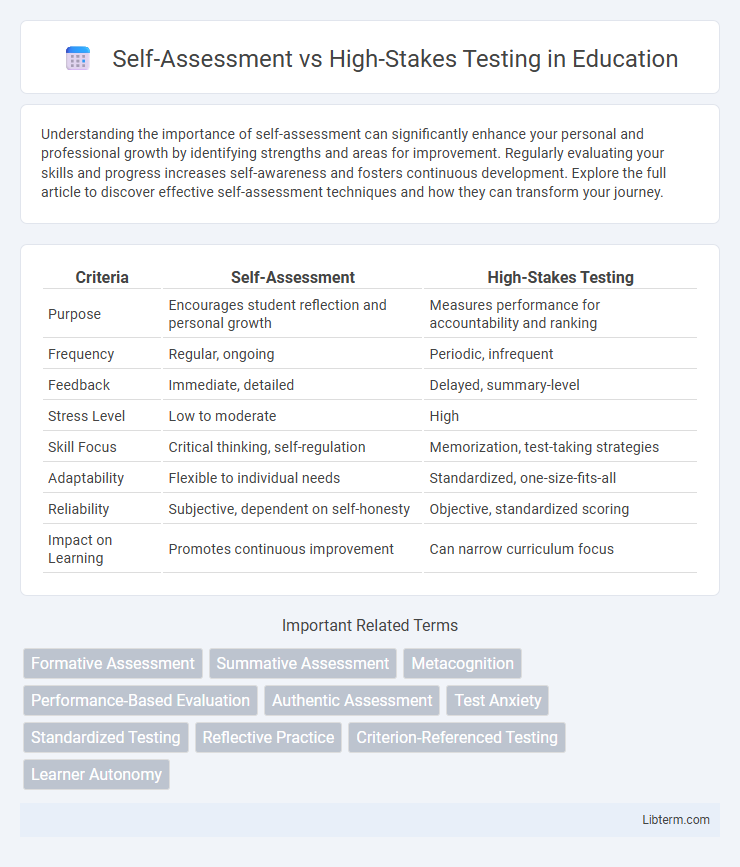Understanding the importance of self-assessment can significantly enhance your personal and professional growth by identifying strengths and areas for improvement. Regularly evaluating your skills and progress increases self-awareness and fosters continuous development. Explore the full article to discover effective self-assessment techniques and how they can transform your journey.
Table of Comparison
| Criteria | Self-Assessment | High-Stakes Testing |
|---|---|---|
| Purpose | Encourages student reflection and personal growth | Measures performance for accountability and ranking |
| Frequency | Regular, ongoing | Periodic, infrequent |
| Feedback | Immediate, detailed | Delayed, summary-level |
| Stress Level | Low to moderate | High |
| Skill Focus | Critical thinking, self-regulation | Memorization, test-taking strategies |
| Adaptability | Flexible to individual needs | Standardized, one-size-fits-all |
| Reliability | Subjective, dependent on self-honesty | Objective, standardized scoring |
| Impact on Learning | Promotes continuous improvement | Can narrow curriculum focus |
Understanding Self-Assessment in Education
Self-assessment in education empowers students to evaluate their own learning progress, fostering deeper metacognitive skills and personalized goal setting. Unlike high-stakes testing, which often emphasizes standardized outcomes, self-assessment encourages reflective practices and continuous improvement. Integrating tools such as rubrics and reflective journals enhances students' ability to identify strengths and areas for growth, promoting long-term academic success.
What Defines High-Stakes Testing?
High-stakes testing is defined by assessments that carry significant consequences for students, educators, or institutions, impacting decisions such as grade promotion, graduation eligibility, or funding allocations. These tests are standardized and designed to measure proficiency in specific subjects, often shaping curriculum and instructional practices. The pressure associated with high-stakes testing influences teaching strategies and student performance, distinguishing it from low-impact self-assessment methods.
Key Differences Between Self-Assessment and High-Stakes Testing
Self-assessment empowers students to evaluate their own learning progress, fostering self-regulation and intrinsic motivation, whereas high-stakes testing measures performance under pressure with significant consequences tied to results. Self-assessments are formative, providing ongoing feedback for improvement, while high-stakes tests are summative, used to make critical decisions such as grade promotion or graduation eligibility. The key differences lie in purpose, timing, and impact on learner autonomy and stress levels.
Benefits of Self-Assessment for Student Growth
Self-assessment fosters deep student engagement by encouraging reflection on personal learning processes, which leads to improved metacognitive skills and autonomy. It provides immediate, personalized feedback that helps learners identify strengths and address weaknesses in real-time, promoting continuous improvement. This process cultivates intrinsic motivation and a growth mindset, essential for long-term academic success and resilience outside standardized testing environments.
Drawbacks and Risks of High-Stakes Testing
High-stakes testing often leads to increased student stress and anxiety, potentially impairing performance and well-being. This testing approach can narrow curriculum focus, encouraging teaching to the test rather than fostering comprehensive learning and critical thinking skills. Moreover, high-stakes exams disproportionately disadvantage students from marginalized backgrounds, exacerbating educational inequality and limiting opportunities for equitable assessment.
Impact on Student Motivation and Engagement
Self-assessment empowers students to actively monitor their learning progress, fostering intrinsic motivation and deeper engagement by promoting self-reflection and ownership of their educational journey. High-stakes testing often induces anxiety and pressure, which can diminish motivation and reduce authentic engagement by framing learning as a means to achieve test performance rather than mastery. Research indicates that integrating formative self-assessment alongside lower-stakes evaluations enhances student agency, leading to sustained motivation and improved academic outcomes.
Reliability and Validity: A Critical Comparison
Self-assessment offers personalized insights into learning progress but often lacks the reliability and validity found in high-stakes testing, which is standardized and rigorously designed to minimize bias. High-stakes tests provide consistent measures across diverse populations, ensuring external validity, while self-assessments may suffer from subjective bias and inconsistent scoring criteria. Balancing the subjective nature of self-assessment with the objectivity of high-stakes testing is crucial for comprehensive educational evaluation strategies.
The Role of Feedback in Each Assessment Method
Self-assessment empowers learners to identify personal strengths and weaknesses through reflective feedback, fostering intrinsic motivation and self-regulated learning. High-stakes testing provides standardized, summative feedback that informs educators and stakeholders about overall proficiency but often lacks individualized guidance for improvement. Integrating timely, specific feedback in both methods enhances learning outcomes by balancing personal growth with objective performance measures.
Integrating Self-Assessment with Traditional Testing
Integrating self-assessment with traditional high-stakes testing enhances student engagement by promoting metacognitive skills and personal accountability. Combining these methods allows educators to gather comprehensive data on student learning, balancing formative insights with summative evaluation. This hybrid approach supports differentiated instruction, improves learning outcomes, and fosters a growth mindset among learners.
Future Trends in Educational Assessment
Future trends in educational assessment emphasize a shift from traditional high-stakes testing toward more frequent and personalized self-assessments that foster student engagement and ongoing feedback. Advances in adaptive technology and data analytics enable customized learning experiences by continuously measuring individual progress, reducing test anxiety associated with single high-pressure exams. The integration of AI-driven assessment tools is expected to enhance accuracy and provide real-time insights, supporting differentiated instruction and promoting lifelong learning skills.
Self-Assessment Infographic

 libterm.com
libterm.com